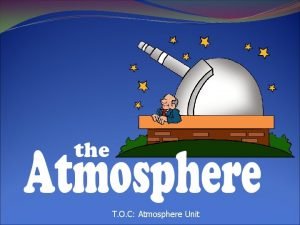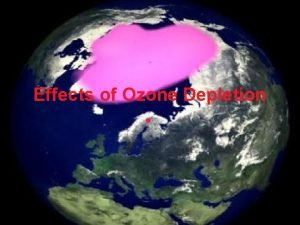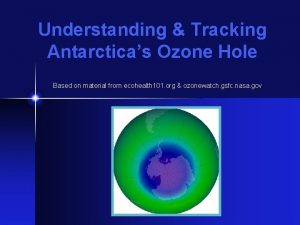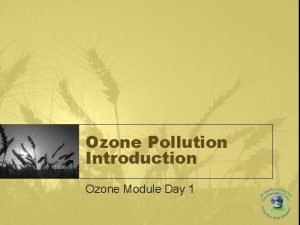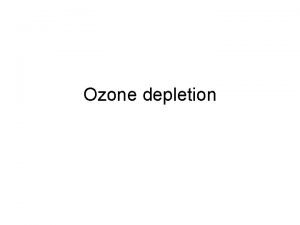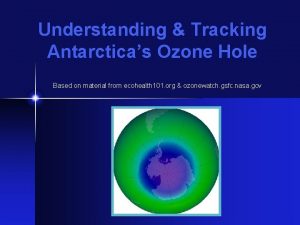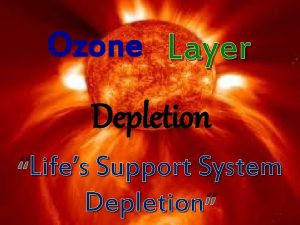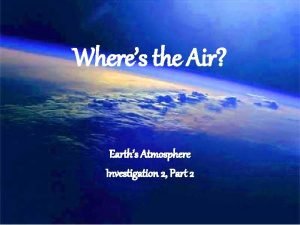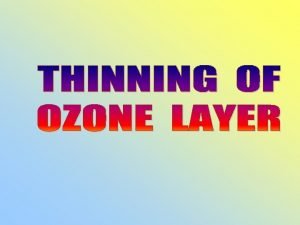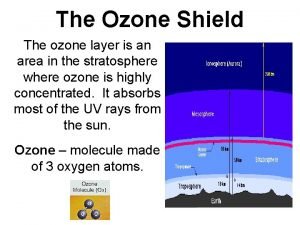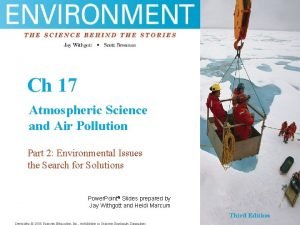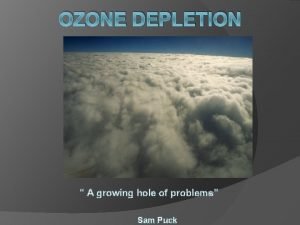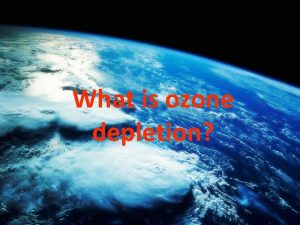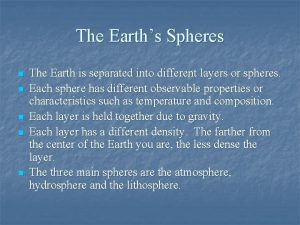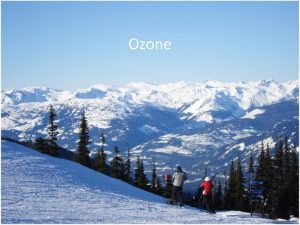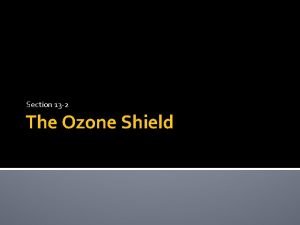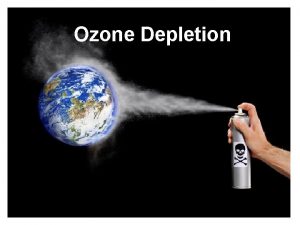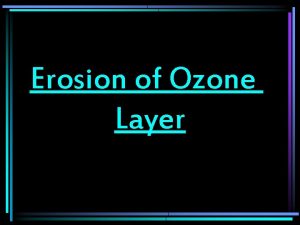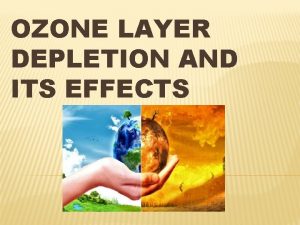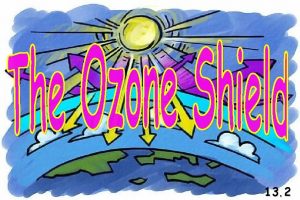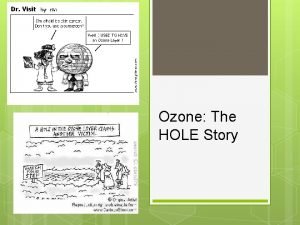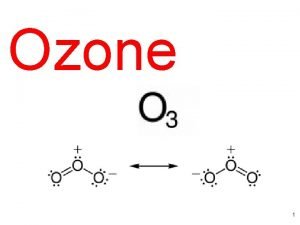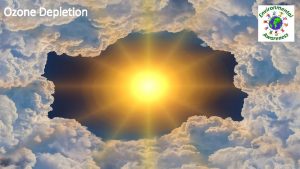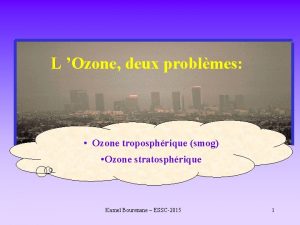The ozone shield Ozone layer is an area















- Slides: 15

The ozone shield Ozone layer is an area in the stratosphere where ozone is highly concentrated. What is ozone? Ozone is a molecule made of three oxygen atoms. The ozone layer absorbs most of the ultraviolet (UV) light from the sun.

“Good” Ozone – naturally in the stratospheric layer of the atmosphere ~10 -30 miles up “Bad” Ozone – ground level, created by chemical reactions between nitrogen oxides, volatile organic compounds and sunlight (vehicle exhaust, gas vapor, solvent) Air Now web link http: //www. airnow. gov/index. cf m? action=airnow. local_city&map center=0&cityid=189

Depletion of the ozone layer allows more ultraviolet (UV) radiation to reach the surface of the Earth. Ultraviolet light is harmful to organisms because it can damage the genetic material in living cells. By shielding the Earth’s surface from most of the sun’s ultraviolet light, the ozone in the stratosphere acts like a sunscreen for the Earth’s inhabitants.

The Ozone Hole Definition: a thinning in the ozone layer that occurs over the poles during the spring. How does it happen? Each year for the past few decades during the Southern Hemisphere spring, chemical reactions involving chlorine and bromine cause ozone in the southern polar region to be destroyed rapidly and severely. Problem: Holes in the ozone layer bring in more UV light.

Ozone Hole History In 1985, results of studies by scientists working in Antarctica revealed that the ozone layer above the South Pole had thinned by 50 to 98 percent. This was the first news of the ozone hole (a thinning of stratospheric ozone that occurs over the poles during the spring). After the results from the studies from Halley Bay were published, NASA scientists reviewed data that had been sent to Earth by the Nimbus 7 weather satellite since the satellite’s launch in 1978. They were able to see the first signs of ozone thinning in the data from 1979. Staff at the South Pole get ready to release a balloon that will carry an ozone instrument up to 20 miles in the atmosphere, measuring ozone levels all along the way.

In 2012, the hole in the ozone layer over Antarctica was smaller than it has ever been in the last 10 years.

The Miracle Chemicals -- chlorofluorocarbons (CFCs) • nonpoisonous and nonflammable • do not corrode metals CFCs were used as coolants in refrigerators and air conditioners. They were used as a propellant in spray cans of everyday products such as deodorants, insecticides, and paint.

Chemicals That Cause Ozone Depletion During the 1970 s, it was discovered that chlorofluorocarbons (CFCs) might be damaging the ozone layer. At the Earth’s surface, CFCs are chemically stable. So, they do not combine with other chemicals or break down into other substances. But CFC molecules break apart high in the stratosphere, where UV radiation, a powerful energy source, is absorbed. Once CFC molecules break apart, parts of the CFC molecules destroy protective ozone. Over a period of 10 to 20 years, CFC molecules released at the Earth’s surface make their way into the stratosphere.

CFC Molecule Break Up UV radiation strikes a CFC molecule which causes a chlorine atom to break away. This chlorine atom continues to enter the cycle and repeatedly destroys ozone molecules. Each CFC molecule contains from one to four chlorine atoms, and scientists have estimated that a single chlorine atom in the CFC structure can destroy 10, 000 ozone molecules.

How Does the Ozone Hole Form? During the dark polar winter, strong circulating winds form over Antarctica, called the polar vortex. The air in the vortex grows extremely cold and clouds form. These clouds are made of water, ice and nitric acid and they are called polar stratospheric clouds. On the surfaces of these clouds, reactions convert the inactive chlorine reservoir chemicals into more active forms like chlorine gas. When the sunlight returns to the South Pole in October, UV light rapidly breaks the bond between the two chlorine atoms, releasing free chlorine into the stratosphere, where it takes part in reactions that destroy ozone molecules. The chlorine atoms rapidly destroy ozone. The ozone hole grows throughout the early spring until temperatures warm and the polar vortex weakens, ending the isolation of the air in the polar vortex. The frozen crystals that make up polar stratospheric clouds provide a surface for the reactions that free chlorine atoms in the Antarctic stratosphere.

Effects of Ozone Thinning on Humans UV light is dangerous to living things because it damages DNA. Exposure to UV light makes the body more susceptible to skin cancer, and may cause certain other damaging effects to the human body. According to the EPA, skin cancer is the most common form of cancer in the United States. One in five Americans will develop skin cancer in their lifetime. One American dies from skin cancer every hour.

Effects of Ozone Thinning on Animals and Plants High levels of UV light can: • Kill phytoplankton that live near the surface of the ocean. The loss of phytoplankton could disrupt ocean food chains and reduce fish harvests. • Increased UV light could be damaging for amphibians -- eggs lack shells and are in the shallow water of ponds and streams. Health of amphibian populations are an indicator of environmental change due to their sensitivity. • Damage plants by interfering with photosynthesis, resulting in lower crop yields. Marine organisms living in shallow water experience damaging levels of UV radiation. A healthy green sea urchin embryo on left. A UV-irradiated green sea urchin embryo on right displays an abnormal, extruded gut.

Damaging Effects of UV Light Humans • increased incidence of skin cancer • premature aging of the skin • increased incidence of cataracts • weakened immune response Amphibians • death of eggs • genetic mutations among survivors • reduction of populations Marine Life • death of phytoplankton in surface water • disruption of food chain • reduction in the number of photosynthesizers Land Plants • interference with photosynthesis • reduced crop yields

Protecting the Ozone Layer In 1987, a group of nations met in Canada and agreed to take action against ozone depletion. Under an agreement called the Montreal Protocol, the UN nations agreed to sharply limit their production of CFCs. A second conference on the problem was held in Copenhagen, Denmark, in 1992. Aerosol cans no longer use CFCs as propellants, and air conditioners are becoming CFC free. Today, all UN recognized nations have ratified the treaty and continue to phase out the production of chemicals that deplete the ozone layer while searching for ozone-friendly alternatives.

Chlorofluorocarbon production has declined greatly since developed countries agreed to ban CFCs in 1987. The battle to protect the ozone layer is not over. CFC molecules remain active in the stratosphere for 60 to 120 years. CFCs released 30 years ago are still destroying ozone today, so it will be many years before the ozone layer completely recovers.
 Atmosphere unit
Atmosphere unit Ozone layer depletion effects on humans
Ozone layer depletion effects on humans Causes of the ozone depletion
Causes of the ozone depletion Protective ozone layer
Protective ozone layer Ozone layer
Ozone layer Ozone layer depletion introduction
Ozone layer depletion introduction Ozone layer levels
Ozone layer levels Ozone layer depletion
Ozone layer depletion Wheres the ozone layer
Wheres the ozone layer Herbicides definition ap human geography
Herbicides definition ap human geography Ozone layer made up of
Ozone layer made up of Effect of ozone depletion on plants
Effect of ozone depletion on plants Copyright
Copyright Ozone layer simple definition
Ozone layer simple definition Protection of ozone layer
Protection of ozone layer Protective ozone layer
Protective ozone layer
